Before I get to the KAS Kent History Showcase at Dover Museum and Market Square last Saturday 3 June, I’m going to bring you news about Dr Diane Heath’s NLHF Medieval Animals Heritage project conference, the ‘Working with Wills’ workshops, and my talk at St Thomas’s/Eastbridge hospital.
Starting with Diane’s conference, this will be from Wednesday 28 June to Saturday 1 July. Entitled, ‘Skin and Bone, Wood and Stone’, as she says, the conference “is about our fantastic but little-known Kent medieval and early modern animal heritage (think Fantastic Beasts and Pokemon but older and weirder), placed in a wider context by British and international scholars.” The conference will take place at Old Sessions House, Canterbury Christ Church University and is free, but please book so that the organisers can anticipate attendance. For more details of the twelve panel sessions and other events, including an exhibition, where speakers will discuss all sorts of animals from unicorns to werewolves to dragons, please see https://www.canterbury.ac.uk/arts-and-culture/event-details.aspx?instance=424806 and on Saturday 1 July as a linked event, we have the Canterbury Medieval Pageant procession and family trail, 11am to 5pm. As regular readers of the blog will know, the theme for the Canterbury Pageant this year is ‘Medieval Animals’, so do watch out for the giant puppets! Such puppets being a long Canterbury and east Kent tradition going back at least to the later Middle Ages, and probably rivalling their medieval counterparts at London and Norwich, which had Snap the Dragon!
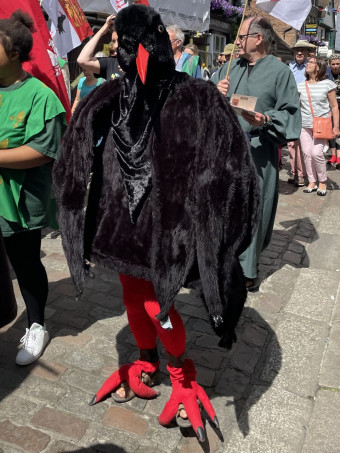
As part of the CKHH initiative to work with Dover Museum and the Maison Dieu to offer outreach activities on ‘Kent’s Maritime Communities’, the three ‘Working with Wills’ workshops and associated ‘From the Cradle to the Grave: living, working and dying in late medieval Dover’ temporary exhibition will be in St Mary’s church, Dover thanks to the generosity of the Revd Catherine Tucker. The workshops will be led by me, and Kieron Hoyle will join us too. Some of you may know from her recent appearances in the blog, including details about her PhD project and her meeting with Bishop Rose: https://blogs.canterbury.ac.uk/kenthistory/discovering-east-kent-in-the-company-of-experts/
and she was also at the Kent History Showcase as you’ll see later on.
Back to the wills workshops, wills are a great way to start learning how to read ‘old handwriting’, as well as finding out about the lives of ordinary people – their beliefs, what they had in their houses, and many other things. Each of the 3 afternoon workshops on Saturday 8 July, Monday 17 July and Tuesday 18 July is a stand-alone free event, and no previous experience is necessary. If this sounds interesting, please do book at: https://bit.ly/WillsDoverJuly or email artsandculture@canterbury.ac.uk or call 10112 922994.
Moving to Thursday 27 July at 3pm, I’ll be giving a talk entitled ‘Eastbridge, Pilgrimage and Late Medieval Canterbury’ where we will explore the role of Eastbridge in late medieval Canterbury at a time when pilgrimage, although still valued, was seemingly not drawing the vast numbers of pilgrims who had come at the height of Becket’s cult’s popularity in the early 13th century. As well as investigating late medieval pilgrimage experience in Canterbury and Eastbridge’s place within in, we will look at the other roles the hospital fulfilled in a late medieval city where there were numerous other religious houses as well as parish churches. This talk will take place in the Juxon Room at Eastbridge and there will be refreshments afterwards. For more details and to book, please see: https://pay.sumup.io/b2c/XHM1549OR6 or call 01227 471688.
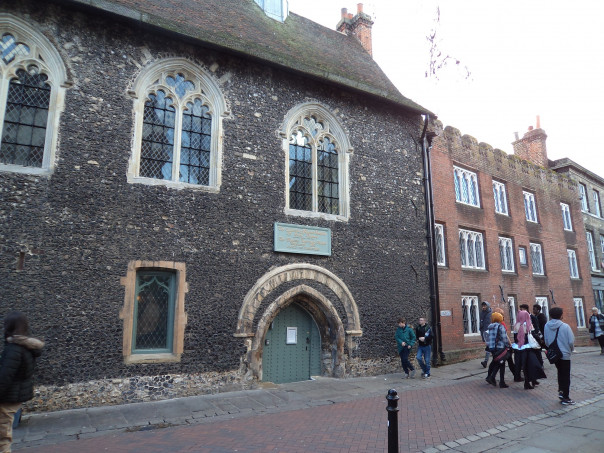
Just a couple of quick notices, Brook Rural Museum, another organisation we have strong links with, is holding two events soon. Firstly, on the same day as other festivities in Brook this Saturday 10 June, the Museum will be holding a Heritage Hop Festival between noon and 4pm. For those who don’t know Brook, it is a village at the foot of the Downs with a fabulous medieval church not far from Wye. Among the treats in store for visitors to the Museum will be guided tours of the early 19th-century circular oast house, face-painting and other family-friendly activities, live music and refreshments. Then on Saturday 15 July there will be a Medieval Craft Fayre at the Museum. Details available soon and for more on the Museum more generally, please see: https://www.agriculturalmuseumbrook.org.uk/
Now to the KAS Kent History Showcase and when Diane and I arrived at Dover Museum last Saturday, we were greeted by Peter Joyce, KAS’s Outreach Officer, Martin Crowther from the Maison Dieu project, Jon Iveson from Dover Museum and Michelle Crowther who, with Professor Carolyn Oulton, would be looking after the CCCU Kent’s Digital Maps project stall. Having unloaded the various pop-up banners, craft materials and other things for the CKHH and Medieval Animals Heritage stalls, we took them up to the second floor where we started setting up before the event opened at 10am. Soon after we were joined by Kieron Hoyle and having organised everything, we agreed that it made sense for Kieron to go and listen to the three talks in the morning, including by Michelle Crowther, while Diane and I talked to visitors about the research and outreach work of the Centre and offered young people the chance to make ‘stained-glass’ lasagne with animals designs roughly based on the medieval bestiary or on medieval stained glass. As a result, we had a growing set of window designs, popular animals being lions, dragons of various kinds and the odd hedgehog. Our young designers were delighted with their creations which they proudly took home, as well as a Medieval Animals Heritage keyring with the project’s hedgehog design, the keyrings having been done for us by Benedict and Kieron on the Friday.
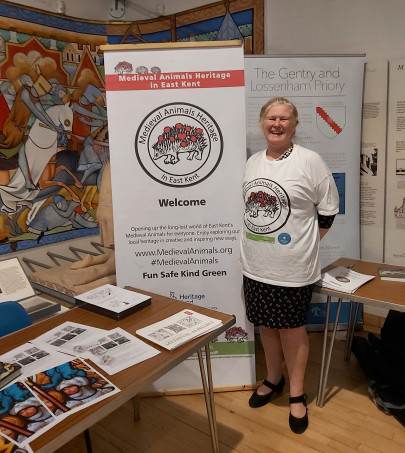
Lunch time brought more people, as well as the return of Kieron which meant I took the opportunity to visit Professor Paul Bennett and his Dover Bronze Age boat team in the Market Square. They, too, had had a busy morning, aided by the good weather because Paul had the replica boat on a trailer there which he discussed with visitors. Lunch time also saw the short ’pilgrimage’ from the Market Square to the seafront for the launch of the Via Francigena ‘We are All Winners’ artwork. This procession was led by the ‘Rough Musicke’ medieval musicians and involved the Mayor of Dover. Peter Joyce captured the procession in a series of photos which, I believe, will go on the Dover website amongst other places.
The three afternoon talks were chaired by Peter, and I joined the audience, leaving Kieron to look after the two stalls upstairs. The first talk was given by Paul Bennett where he gave an illustrated presentation on the finding of the Dover Bronze Age boat in 1992, the way they had had to saw it in pieces to be able to raise it from deep in the ground, the recording and conservation that had been undertaken as the team explored how it had been constructed. Indeed, they found lots of fascinating information during this process such as the 4 types of moss and the wax that had been used as corking material, the adze marks on the oak timbers, the mortice holes and how the boat had been sewn together, and even the remains of an Atlantic salmon which showed that the boat had been sea-going rather than used for river transport.
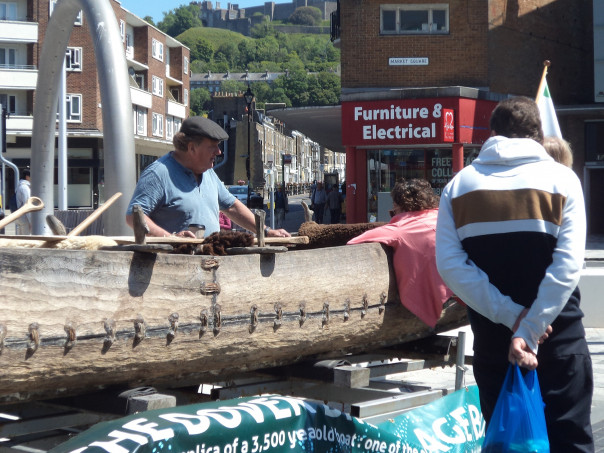
As Paul said, this was all very exciting concerning a three and a half thousand year old boat, but he was keen to try experimental archaeology in terms of building a half scale sea-going vessel if possible using exactly the same methods and materials. Even though using the same methods as in the Bronze Age did defeat the team at times, much of the work was and continues to be done as it was for the original boat. Of course, too, the original boat needed a suitable place to display it, and it was fortunate that the town council was prepared to help. Moreover, funding was received from Europe, the European authorities in France and Belgium showing considerable interest in the project, as they do to this day. As a result, the Dover boat had its own gallery in Dover Museum, displayed within its Bronze Age context, the team has held several conferences and produced a range of publications from academic papers to works of interpretation for children. Yet for Paul, perhaps one of the things that he has most enjoyed regarding the boat is taking the replica out on the water. Its maiden voyage was in Dover harbour, but the team has paddled her to Folkestone and back, as well as down the Thames, but sadly from Paul’s standpoint never actually across the Channel.
As you can imagine Paul’s presentation generated several questions before we moved on to the second speaker, Hazel Basford, who talked about the use of Quex Park as a VAD hospital in the First World War. This was another interesting presentation, and then we moved finally to Diane Heath’s talk on exotic medieval beasts. Diane began by explaining how ideas about animals had travelled from the Near East to western Europe and how they had been understood and used by churchmen as they tried to understand God’s creation and the role of animals as exempla for Christian thought and teaching. Such ideas were circulating in Anglo-Saxon England, but it was medieval bestiaries, such as the one from Rochester c.1220-30 that Diane used for her animal examples.
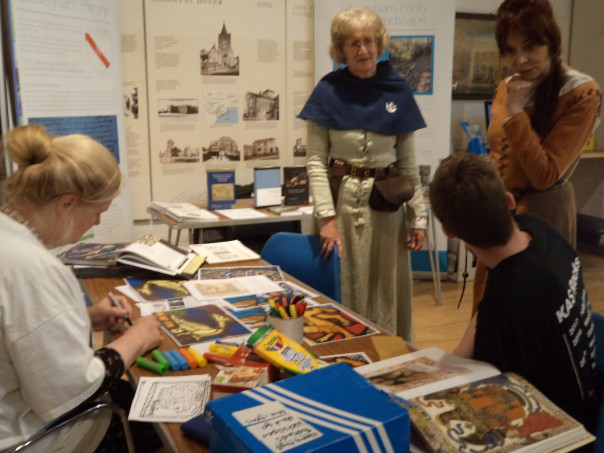
Among the ‘animals’ she discussed were firestones, not as obvious ‘animal’ you might say, but they were thought to be gendered and to have feelings. Furthermore, through touch they were thought to burst into flames, thereby offering ideas about the relationship between Adam and Eve and thus of value in Christian teaching. The use of symbolism is equally applicable from a medieval standpoint concerning lions, this king of the beasts and thus a symbol for Christ said to breathe life into his still-born cubs on the third day. Another fabulous beast was the phoenix, again ideas around re-generation and renewal and Christ, while the unicorn, too, was employed spiritually. For, of course, the only way to kill it was to spear the unicorn when it laid its head in the lap of a maiden as she sat in a forest clearing.
Sirens offered another strange beast being part woman and part bird, while dragons came in a variety of forms, albeit they were known and depicted sitting below the perindens tree, for even though they feared the tree, they wanted to eat the doves which lived in the branches. Thus, we have doves as lay people who when they leave the tree’s protection (God), they fall victim to the devil, the dragon.
As you can imagine, Diane’s presentation, too, provoked questions from the audience and after further discussion, Peter brought the proceedings to a close by thanking all the speakers, Martin and Jon for hosting the event and all the exhibitors who had all helped to make the day a success.
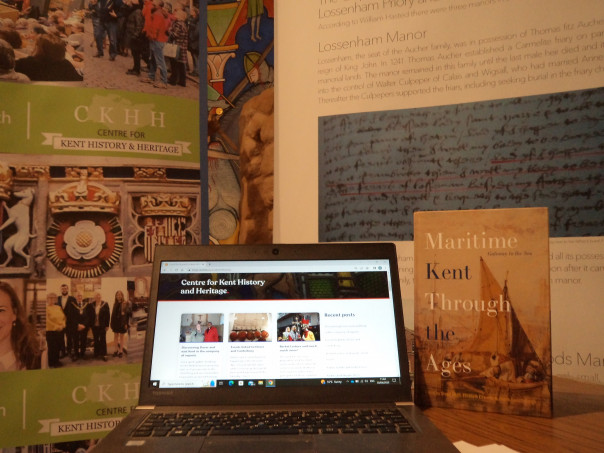
And finally, I just thought I would mention that it was useful to be able to represent the Centre at the University of Kent’s ‘Partnering for Impact: Histories and Heritage’ day on Wednesday this week, as well as attending a Lossenham Project meeting this Friday, while Diane and Martin were working on the interim report for the Heritage Lottery concerning ‘Medieval Animals Heritage’ this week – another busy week!
 Centre for Kent History and Heritage
Centre for Kent History and Heritage Sheila Sweetinburgh
Sheila Sweetinburgh 854
854

